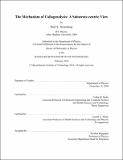The mechanism of collagenolysis : a substrate-centric view
Author(s)
Nerenberg, Paul S
DownloadFull printable version (8.309Mb)
Other Contributors
Massachusetts Institute of Technology. Dept. of Physics.
Advisor
Collin M. Stultz and Leonid A. Mirny.
Terms of use
Metadata
Show full item recordAbstract
Collagenolysis (collagen degradation) is a physiological process involved in normal tissue maintenance, but excessive collagenolysis has been associated with the progression of cancer metastasis, atherosclerosis, and other diseases. Despite considerable efforts to understand the steps involved, the exact mechanism of collagenolysis remains unknown. One proposed mechanism suggests that the enzymes that degrade collagen, collagenases, physically unwind the triple-helical structure of collagen to gain access to the peptide bond that is cleaved. This unwinding mechanism would in principle have large energetic requirements, but neither ATP nor other energy-rich molecules are necessary for collagenolysis. An alternative mechanism is that collagen exists in multiple states, some featuring structures that are unfolded in the vicinity of the collagenase cleavage site, and that collagenases preferentially bind to and stabilize these partially unfolded structures before degradation occurs. The focus of this work is to investigate this alternative mechanism, particularly as it pertains to the conformational ensemble of collagen, using both experimental and computational methods. In particular, this work concentrates on: (1) devising a reaction scheme for this mechanism and verifying that it can explain existing experimental observations; (2) generating a structural model of the type I collagen collagenase cleavage site using molecular dynamics simulations; (3) validating this structural model by performing degradation experiments and analyzing them in light of the reaction scheme described in (1); and (4) validating a similar structural model for type III collagen by designing and characterizing a self-assembling collagen-like model peptide that includes the sequence of the collagenase cleavage site. Together, these data present a detailed and comprehensive analysis of the conformational ensemble of collagen near the collagenase cleavage site and its role in the molecular mechanism of collagen degradation.
Description
Thesis (Ph. D.)--Massachusetts Institute of Technology, Dept. of Physics, 2010. This electronic version was submitted by the student author. The certified thesis is available in the Institute Archives and Special Collections. Cataloged from student submitted PDF version of thesis. Includes bibliographical references.
Date issued
2010Department
Massachusetts Institute of Technology. Department of PhysicsPublisher
Massachusetts Institute of Technology
Keywords
Physics.